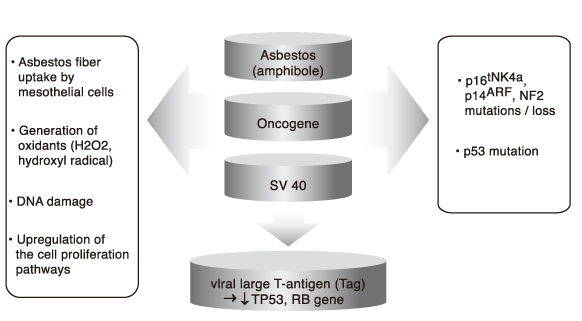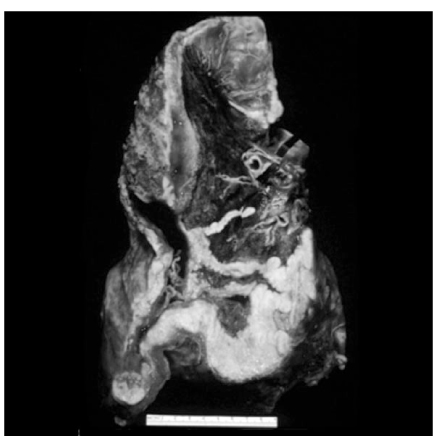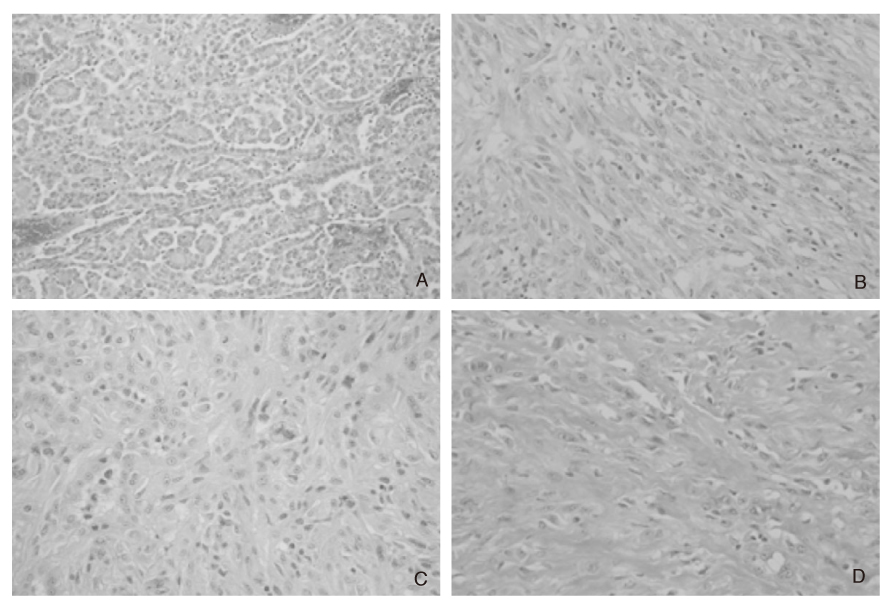J Korean Med Assoc.
2009 May;52(5):456-464. 10.5124/jkma.2009.52.5.456.
Pathological Diagnosis of Malignant Mesothelioma
- Affiliations
-
- 1Department of Pathology, Yonsei University Wonju College of Medicine, Korea. soonheej@yonsei.ac.kr
- KMID: 2188005
- DOI: http://doi.org/10.5124/jkma.2009.52.5.456
Abstract
- Malignant mesothelioma is a primary tumor of the serosal membranes, occurring in the pleura, peritoneum, pericardium, tunica vaginalis, and other related anatomical sites. It is well known that malignant mesothelioma may be a difficult tumor to diagnose pathologically. For the reliable diagnosis of mesothelioma, the adequate representative tissue samples are essential for the routine histology, histochemistry, electron microscopy, and immunohistochemical test. The main differential diagnosis includes metastatic adenocarcinomas or metastatic sarcomas, and even benign mesothelial diseases. As a practical diagnostic method for differential diagnosis of malignant mesothelioma, the immunohistochemistry using a panel of antibodies (positive and negative markers) is considered as the most valuable and useful tool. The use of at least 2 mesothelial markers and 2 or more epithelial markers is recommended, and a diagnostic panel including calretinin, Wilms tumor product 1, cytokeratin 5/6, carcinoembryonic antigen (CEA), and thyroid transcription factor (TTF)-1 could be helpful.
MeSH Terms
-
Adenocarcinoma
Antibodies
Calcium-Binding Protein, Vitamin D-Dependent
Carcinoembryonic Antigen
Diagnosis, Differential
Immunohistochemistry
Keratins
Membranes
Mesothelioma
Microscopy, Electron
Pericardium
Peritoneum
Pleura
Sarcoma
Thyroid Gland
Transcription Factors
Wilms Tumor
Antibodies
Calcium-Binding Protein, Vitamin D-Dependent
Carcinoembryonic Antigen
Keratins
Transcription Factors
Figure
Reference
-
1. King JE, Galateau-Salle F, Hasleton PS. O'Byrne K, Rusch V, editors. Histopathology of malignant mesothelioma. Malignant pleural mesothelioma. 2006. 1st ed. New York: Oxford;61–103.2. Galateau-Salle F, editor. Pathology of malignant mesothelioma. 2006. 1st ed. London: Springer-Verlag;50–182.3. Ramos-Nino ME, Martinelli M, Scapoli L, Mossman BT. Pass HI, Vogelzang NJ, Carbone M, editors. Asbestos-induced mesothelioma. Malingnant mesothelioma. 2005. 1st ed. New York: Springer Science + Business Media;21–33.
Article4. Bocchetta M, Di Resta I, Powers A. Human mesothelial cells are unusually susceptible to simian virus 40-mediated transformation and asbestos cocarcinogenicity. Proc Natl Acad Sci USA. 2000. 97:10214–10219.
Article5. Churg A, Inai K, Samet JM, Roggli V, Praet M, Weill H, Galateau-Salle F, Ordόñez NG, Rusch V, Cagle PT, Hammar SP, Colby TV, Gibbs AR, Testa JR, Vogt P, Hasleton PS, Gazdar AF, Brambilla E, Henderson DW, Saracci R, Travis WD, Vignaud JM, Pugatch R. Travis WD, Brambilla E, Muller-Hermelink HK, Harris CC, editors. Mesothelioma in Tumours of the pleura. WHO classification of tumours. Pathology & Genetics. Tumours of the lung, pleura, thymus and heart. 2004. 1st ed. Lyon: IARCPress;128–136.6. Attanoos RL, Gibbs AR. 'Peudomesotheliomatous' carcinomas of the pleura: a 10-year analysis of cases from the environmental lung disease research group, Cardiff. Histopathol. 2003. 43:444–452.
Article7. Koss MN, Fleming M, Przygodzki RM, Sherrod A, Travis W, Hochholzer L. Adenocarcinoma simulating mesothelioma: A clinicopatholgoical and immunohistochemical study of 29 cases. Ann Diagn Pathol. 1998. 2:93–102.
Article8. Addis B, Roche H. Problems in mesothelioma diagnosis. Histopathol. 2008. 54:55–68.
Article9. Attanoos RL, Griffin A, Gibbs AR. The use of immunohistochemistry in distinguishing reactive from neoplastic mesothelium. A noveluse for desmin and comparative evaluation with epithelial membrane antigen, p53, platelet-derived growth factor-receptor, P-glycoprotein and Bcl-2. Histopathol. 2003. 43:231–238.
Article10. Marchevsky AM. Application of immunohistochemistry to the diagnosis of malignant mesothelioma. Arch Pathol Lab Med. 2008. 132:397–401.
Article11. King JE, Thatcher N, Pickering CAC, Hasleton PS. Sensitivity and specificity of immunohistochemical antibodies used to distinguish between benign and malignant pleural disease: a systemic review of published reports. Histopathol. 2006. 49:561–158.12. King JE, Thatcher N, Pickering CAC, Hasleton PS. Sensitivity and specificity of immunohistochemical markers used in the diagnosis of epithelioid mesothelioma: a detailed systemic analysis using publishing data. Histopathol. 2006. 48:223–232.
Article13. Chu AY, Litzky LA, Pasha TL, Acs G, Zhang PJ. Utility of D2-40, a novel mesothelial marker, in the diagnosis of malignant mesothelioma. Mod Pathol. 2005. 18:105–110.
Article14. Ordonez NG. D2-40 and podoplanin are highly specific and sensitive immunohistochemical markers of epithelioid malignant mesothelioma. Hum Pathol. 2005. 36:372–380.
Article15. Ordonez NG. Value of mesothelin immunostaining in the diagnosis of mesothelioma. Mod Pathol. 2003. 16:192–197.
Article16. Ordonez NG. Application of mesothelin immunostaining in tumor diagnosis. Am J Surg Pathol. 2003. 27:1418–1428.
Article17. Butnor KJ, Nicholson AG, Allred DC, Zander DS, Henderson DW, Barrios R, Haque AK, Allen TC, Killen DE, Cagle PT. Expression of renal cell carcinoma-associated markers erythropoietin, CD10, and renal cell carcinoma marker in diffuse malignant mesothelioma and metastatic renal cell carcinoma. Arch Pathol Lab Med. 2006. 130:823–827.
Article18. Comin CE, Saieva C, Masserini L. h-caldesmon, calretinin, estrogen receptor, and Ber-EP4: a useful combination of immunohistochemicl markers for differentiating epithelioid peritoneal mesothelioma from serous papillary carcinoma of the ovary. Am J Surg Pathol. 2007. 31:1139–1148.
Article19. Barnetson RJ, Burnett RA, Downie I, Harper CM, Roberts F. Immunohistochemical analysis of peritoneal mesothelioma and primary and secondary serous carcinoma of the peritoneum: antibodies to estrogen and progesterone receptors are useful. Am J Clin Pathol. 2006. 125:67–76.
Article20. Lucas DR, Pass HI, Madan SK, Adsay NV, Wali A, Tabaczka P, Lonardo F. Sarcomatoid mesothelioma and its histological mimics: a comparative immunohistochemical study. Histopathol. 2003. 42:270–279.
Article21. Ordonez NG. What are the current best immunohistochemical markers for the diagnosis for epithelioid mesothelioma? A review and update. Hum Pathol. 2007. 38:1–16.22. Stevenson AJ, Chatten J, Bertoni F, Miettinen M. CD99 (p30/32MIC2) Neuroectodermal/Ewing's sarcoma antigen as an immunohistochemical marker: review of more than 600 tumors and the literature experience. Appl Immunohistochem. 1994. 2:231–240.23. Amary MF, Berisha F, Bernadi FC, Herbert A, James M, Reis-Filho JS, Fisher C, Nicholson AG, Tirabosco R, Diss TC, Flanagan AM. Detection of SS18-SSX fusion transcripts in formalin-fixed paraffin-embedded neoplasms: analysis of conventional RT-PCR, qRT- PCR and dual color FISH as diagnostic tools for synovial sarcomas. Mod Pathol. 2007. 20:482–496.
Article24. Corson J. Pathology of mesothelioma. Thorac Surg Clin. 2004. 14:447–460.
Article25. Cagle PT, Brown RW, Leibowitz RM. P53 immunostaining in the differentiation of reactive processes from malignancy in pleural biopsy specimens. Hum Pathol. 1994. 25:443–448.
Article26. Cagle PT, Churg A. Differential diagnosis of benign and malignant mesothelial proliferations on pleural biopsies. Arch Pathol Lab Med. 2005. 129:1421–1427.
Article27. Ordóñez NG. Immunohistochemical diagnosis of epithelioid mesothelioma: an update. Arch Pathol Lab Med. 2005. 129:1407–1414.
Article28. Suster S, Moran C. Applications and limitations of immunohistochemistry in the diagnosis of malignant mesothleioma. Adv Anat Pathol. 2006. 13:316–329.
Article29. Comin CE, Dini S, Novelli , Santi R, Asirelli G, Messerini L. Hcaldesmon, a useful positive marker in the diagnosis of pleural malignant mesotheioma, epithelioid type. Am J Surg Pathol. 2006. 30:463–469.
Article30. Yaziji H, Battifora H, Barry TS, Hwang HC, Bacchi CE, McIntosh MW, Kussick SJ, Gown AM. Evaluation of 12 antibodies for distinguishing epithelioid mesothelioma from adenocarcinoma: identification of a three-antibody immunohistochemical panel with maximal sensitivity and specificity. Mod Pathol. 2006. 19:514–523.
Article
- Full Text Links
- Actions
-
Cited
- CITED
-
- Close
- Share
- Similar articles
-
- A Case of Malignant Mesothelioma of the Uterus
- The peritoneal mesothelioma: 4 cases report
- Two cases of malignant mesothelioma of the peritoneum and pericardium
- Malignant peritoneal mesothelioma with nonspecific history: a case report
- Localized Malignant Mesothelioma of Peritoneum Arising in the Liver Capsule: A Case Report




